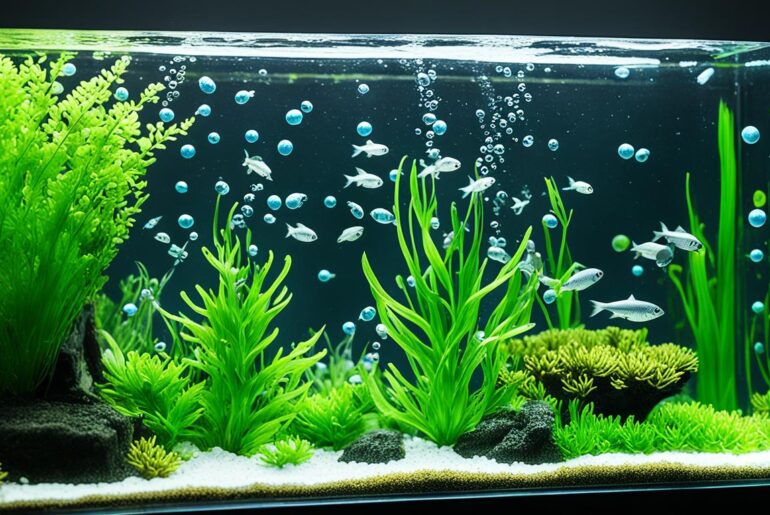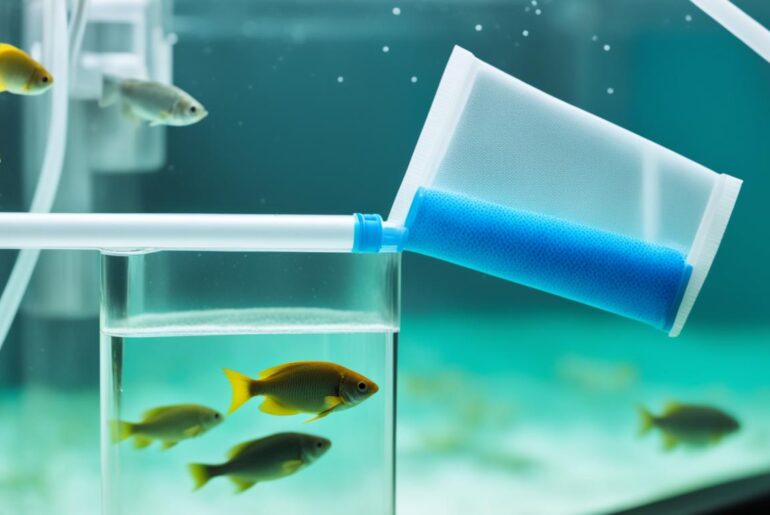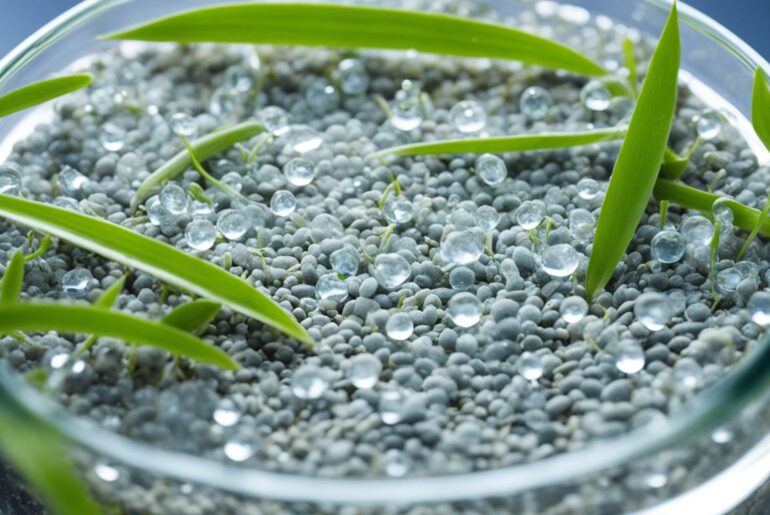As an avid fish lover, I’ve always strived to provide the best care for my underwater companions. It wasn’t until I delved into the world of aquarium cycling that I realized the crucial role water changes play in creating a healthy habitat for fish.
Like many others, I used to believe that leaving the water untouched during the cycling process was the best approach. It seemed logical to let nature take its course without any interference. However, I soon discovered that this misconception could harm the very creatures I was trying to protect.
One fateful day, I noticed my fish becoming lethargic and displaying signs of distress. Concerned, I reached out to an experienced aquarist who enlightened me about the importance of water changes during the cycling process. It was a eureka moment for me as I realized my neglect in this aspect.
From that day forward, I made it a priority to perform small and frequent water changes while cycling my aquarium. Not only did I witness a significant improvement in the overall health and behavior of my fish, but I also learned about the science behind this essential practice.
Today, I want to share this valuable knowledge with you, so you can provide the best care for your aquatic friends. Let’s explore the benefits of water changes during the aquarium cycling process and debunk some common misconceptions along the way.
Key Takeaways:
- Performing water changes during the aquarium cycling process is crucial for ensuring the health and well-being of your fish.
- Contrary to misconceptions, frequent small water changes can actually speed up the cycling process and prevent harm to the fish.
- Water changes help to keep ammonia and nitrite levels low, which are toxic to fish.
- Neglecting water changes during cycling is inhumane and irresponsible.
- By incorporating water changes into your aquarium cycling routine, you can create a thriving and safe environment for your aquatic companions.
The Benefits of Doing Water Changes in a Cycling Aquarium
Performing small, frequent water changes in a cycling aquarium not only aids the cycling process but also helps maintain the health of the fish. It does not delay or hamper the cycling process; in fact, it may even speed it up slightly. Water changes help to reduce elevated levels of ammonia and nitrite, which are harmful to fish. They also replenish oxygen in the water, essential for both fish and the growth of beneficial bacteria.
During the cycling process, ammonia and nitrite levels can rise as the beneficial bacteria responsible for breaking down these toxins establish themselves in the aquarium’s biological filter. By performing regular water changes, you can help keep these levels in check and provide a healthier environment for your fish.
Regular water changes are crucial for ensuring the well-being of your fish during the cycling process. By reducing harmful toxins and replenishing oxygen, you create a more favorable and stress-free environment for your aquatic friends to thrive.
Water changes not only benefit the fish but also play a vital role in cultivating beneficial bacteria. These bacteria are crucial for establishing a stable and well-functioning biological filter, which helps breakdown and remove harmful substances from the water. By replenishing oxygen through water changes, you provide a conducive environment for the growth and colonization of these bacteria, facilitating a smoother cycling process.
Additionally, water changes help remove accumulated debris, uneaten food, and other waste materials from the aquarium, preventing the buildup of ammonia and nitrite. This helps maintain water quality and reduces the risk of fish stress and disease.
Performing small, frequent water changes during the cycling process also allows you to monitor and maintain stable water parameters, such as temperature and pH. This ensures that the cycling process progresses smoothly and optimally, promoting a healthier environment for your fish.
| The Benefits of Water Changes in a Cycling Aquarium |
|---|
| Helps reduce elevated levels of ammonia and nitrite |
| Replenishes oxygen, essential for fish and growth of beneficial bacteria |
| Aids in cultivating beneficial bacteria and establishing a stable biological filter |
| Removes debris, uneaten food, and waste materials |
| Maintains water quality and reduces the risk of fish stress and disease |
| Allows for monitoring and maintaining stable water parameters |
Why Some People Discourage Water Changes During Cycling
During the cycling process of an aquarium, there are misconceptions that lead some people to discourage water changes. These individuals believe that water changes will disturb the bacteria or remove them from the tank, hindering their establishment. However, it is important to understand that the bacteria responsible for the biological filtration in an aquarium are typically attached to surfaces rather than freely floating in the water.
“Some people believe that water changes will disturb the bacteria or remove them from the tank, preventing them from establishing.”
Water changes, especially small and frequent ones, do not remove significant quantities of bacteria from the biological filter. The bacteria remain securely attached to the surfaces within the tank, ensuring their presence and functionality. So, there is no need to worry that water changes will disrupt or displace the beneficial bacteria that play a crucial role in the cycling process.
“The bacteria responsible for the biological filtration are typically attached to surfaces within the tank.”
Another concern associated with water changes during cycling is the fear that lowering ammonia levels in the water will starve or kill off the bacteria. It is important to note that regular small water changes only remove a fraction of the ammonia present in the aquarium. There is still enough ammonia remaining for the bacteria to consume and facilitate their growth.
“Regular small water changes only remove a fraction of the ammonia present in the aquarium.”
The misconception that water changes are detrimental during the cycling process can lead to unnecessary worry and confusion among aquarium enthusiasts. Understanding the nature of the bacteria in the biological filter and their resilience to water changes is key to dispelling these misconceptions.
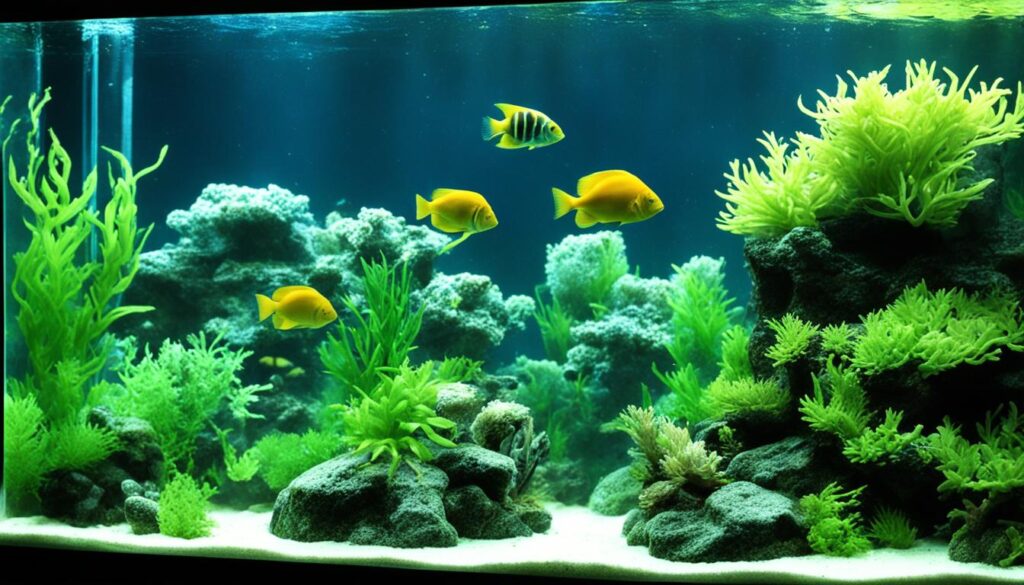
How Water Changes Speed Up the Cycling Process
In a cycling aquarium, water changes play a crucial role in accelerating the process and ensuring a healthy environment for fish. By reducing ammonia and nitrite levels, which are harmful to fish, water changes create favorable conditions for the growth of nitrifying bacteria. These bacteria are responsible for converting ammonia to nitrite and nitrite to nitrate, completing the nitrogen cycle.
Elevated levels of ammonia and nitrite not only harm the fish but also hinder the growth of beneficial bacteria. By removing some of the waste through water changes, the remaining waste is processed more efficiently by the bacteria. This allows for faster establishment of the biological filter, which is essential for maintaining water quality and fish health.
The Impact of Water Changes on the Cycling Process
Water changes help to:
- Reduce harmful ammonia and nitrite levels
- Promote the growth of beneficial nitrifying bacteria
- Improve overall water quality
- Provide a healthier habitat for fish
By regularly performing small water changes, you create a stable and healthy environment for fish, allowing them to thrive throughout the cycling process. Remember to dechlorinate the water and match its temperature to prevent additional stress to the fish.
“Water changes in a cycling aquarium are like refreshing the ecosystem, creating optimal conditions for the colonization of beneficial bacteria and the well-being of fish.”
| Impact of Water Changes on the Cycling Process | Benefits |
|---|---|
| Reduces ammonia and nitrite levels | Prevents harm to fish and aids bacterial growth |
| Promotes the growth of nitrifying bacteria | Allows for faster establishment of the biological filter |
| Improves overall water quality | Creates a healthier habitat for fish |
The Importance of Cycling an Aquarium
When it comes to keeping fish, aquarium cycling is of utmost importance to ensure the health and well-being of your aquatic companions. By establishing a stable and biologically safe environment, cycling plays a vital role in maintaining fish health and preventing potential issues.
The process of aquarium cycling revolves around the nitrogen cycle, which involves the conversion of toxic ammonia into less harmful substances. This cycle is facilitated by nitrifying bacteria, which thrive in an established tank.
Without proper cycling, the levels of ammonia and nitrite can quickly rise, posing a significant threat to fish health. Elevated ammonia levels can lead to stress, tissue damage, and even death. Additionally, nitrite poisoning can cause issues with oxygen transport in the fish’s bloodstream.
Cycling an aquarium ensures that the biological filters are equipped to handle the waste produced by the fish. By establishing a healthy population of nitrifying bacteria, ammonia is effectively converted into nitrite and eventually into nitrate, which is less toxic to fish. This creates a stable and safe environment for your finned friends to thrive.
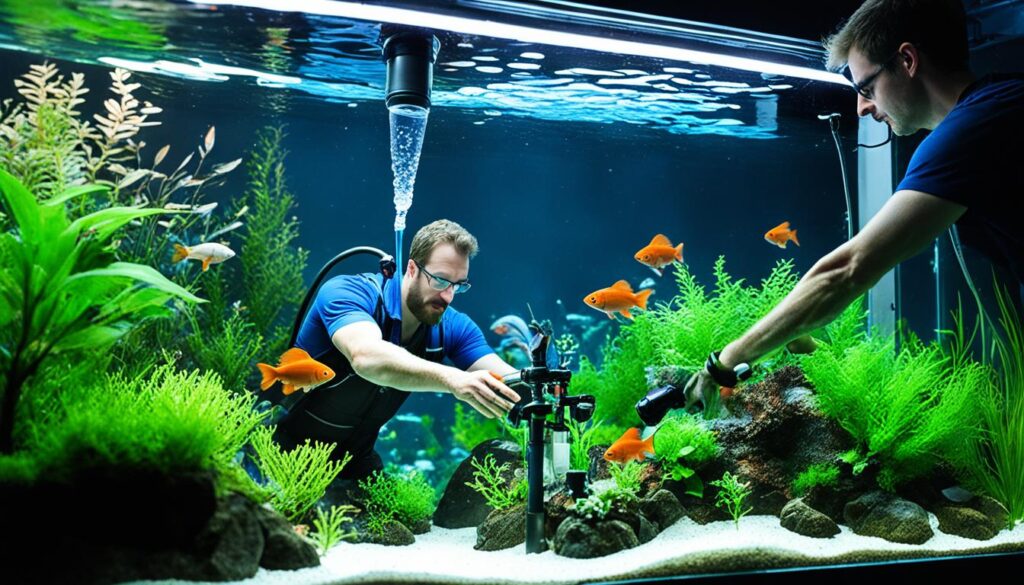
The Nitrogen Cycle in Detail
| Stage | Description |
|---|---|
| 1. Ammonia Production | Fish produce waste, including ammonia, through respiration and excretion. |
| 2. Nitrosomonas Bacteria | Nitrosomonas bacteria convert ammonia (NH3) into nitrite (NO2-). |
| 3. Nitrite Accumulation | Nitrite levels rise, which can be harmful to fish. |
| 4. Nitrobacter Bacteria | Nitrobacter bacteria convert nitrite (NO2-) into nitrate (NO3-). |
| 5. Nitrate Removal | Nitrates are removed through partial water changes or by plants in a planted tank. |
A well-cycled aquarium helps establish a natural balance within the tank. By allowing the nitrogen cycle to complete, you create a healthy and sustainable ecosystem for your fish to thrive.
Proper aquarium cycling is especially crucial for newly set up tanks or when introducing new fish. Without a well-established cycle, the elevated levels of ammonia and nitrite can lead to “New Tank Syndrome,” a condition where fish experience stress and potential health issues due to an unstable environment.
Remember to regularly monitor water parameters, such as ammonia, nitrite, and nitrate levels, during the cycling process. This will help ensure that the levels remain within safe ranges for your fish. Conducting small, regular water changes as needed will also aid in maintaining optimal conditions for your aquatic friends.
By prioritizing aquarium cycling and understanding the significance of the nitrogen cycle, you can provide a healthy and thriving habitat for your fish, promoting their well-being and longevity.
Timeline for Aquarium Cycling
When it comes to aquarium cycling, patience is key. This process typically takes four to eight weeks to complete, although the duration can vary depending on factors such as tank size, water pH, and temperature. By monitoring and maintaining appropriate water parameters, you can help expedite the cycling process and create a healthy environment for your fish.
During the cycling process, it’s essential to regularly test the levels of ammonia, nitrite, and nitrate in your tank. These tests will provide you with valuable insights into the progress of the cycle. As the cycle progresses, you will notice changes in these levels.
Ammonia Levels:
At the beginning of the cycle, you can expect ammonia levels to be high as waste and decomposing food release ammonia into the water. However, as the cycle progresses, the colonies of beneficial bacteria that convert ammonia into nitrite will start to establish. As a result, ammonia levels will gradually decrease.
Nitrite Levels:
As the ammonia levels decrease, nitrite levels will begin to spike. This is an indication that the second group of beneficial bacteria is growing. These bacteria convert nitrite into nitrate, which is less harmful to fish. Eventually, nitrite levels will start to decline as nitrate-producing bacteria populate the tank.
Nitrate Levels:
Once the beneficial bacteria colonies are fully established, you will notice a rise in nitrate levels. At this stage, ammonia and nitrite levels should be zero, indicating a complete cycle. The presence of nitrates confirms that the biological filter is functioning effectively, as nitrates are the end product of the nitrogen cycle.
To maintain a healthy aquarium, it’s important to keep nitrate levels in check through regular water changes. Nitrates can be harmful to fish in high concentrations, and water changes help dilute this toxin.
| Week | Ammonia Levels | Nitrite Levels | Nitrate Levels |
|---|---|---|---|
| 1-2 | High | 0 ppm | 0 ppm |
| 2-4 | Decreasing | Increasing, then decreasing | Increasing |
| 4-8 | 0 ppm | 0 ppm | Increasing |
Remember, every aquarium is unique, and the cycling timeline can vary. By closely monitoring your water parameters and following good aquarium maintenance practices, you can create a thriving environment for your fish.

How to Cycle an Aquarium – Step by Step Guide
Properly cycling an aquarium is essential for creating a healthy and stable environment for your fish. By following these step-by-step instructions, you can ensure a successful cycling process:
Gather the Necessary Equipment
Before you start cycling your aquarium, make sure you have all the necessary equipment:
- Aquarium tank
- Filter system
- Heater (if needed)
- Air pump (optional)
- Water testing kit
- Ammonia source (if cycling fishless)
- Dechlorinator
Set Up the Aquarium
Once you have all the equipment, it’s time to set up your aquarium:
- Choose a suitable location for your aquarium, away from direct sunlight and major temperature fluctuations.
- Clean the aquarium and rinse it thoroughly with water. Avoid using soap or any cleaning agents that may be harmful to fish.
- Place the substrate and any decorative elements in the aquarium.
- Fill the tank with dechlorinated water and adjust the temperature to the appropriate level for your fish.
- Install the filter system and any additional equipment you may have.
- Turn on the heater and let the water temperature stabilize.
Choose Your Cycling Method
There are two main methods for cycling an aquarium:
- Cycling with fish: Add a few hardy fish to your aquarium to produce ammonia through their waste. This method can be more stressful for the fish and requires close monitoring of water parameters and frequent water changes.
- Fishless cycling: Use an alternative source of ammonia, such as fish food or ammonia solution, to kick-start the cycling process. This method is more humane and allows for better control of ammonia levels.
Monitor Water Parameters
During the cycling process, it’s important to monitor the water parameters regularly:
- Test the water for ammonia, nitrite, nitrate, pH, and temperature using a reliable water testing kit.
- Record the readings and track the changes in ammonia and nitrite levels over time.
- Adjust the cycling process accordingly by performing water changes or adding ammonia as needed.
Be Patient and Wait for the Cycle to Complete
Cycling an aquarium requires patience as it can take several weeks for the cycle to complete. During this time, the beneficial bacteria will establish and convert harmful ammonia and nitrite into less toxic nitrate. Be patient and resist the urge to add fish until the cycling process is complete.
Complete the Cycling Process
Once the ammonia and nitrite levels consistently read zero, and nitrate is being produced, the cycling process is complete. At this point, your aquarium is ready for fish!
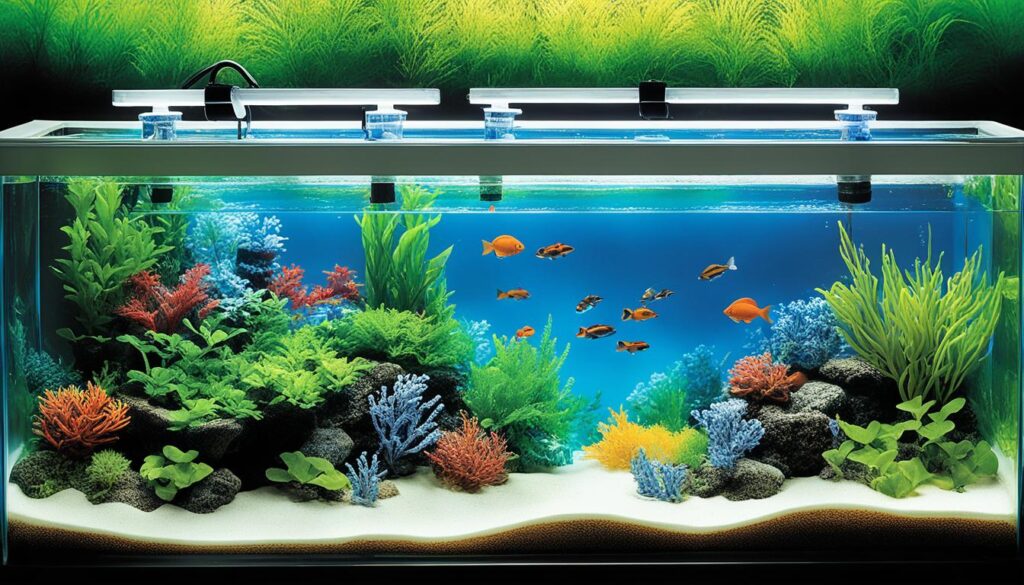
| Step | Description |
|---|---|
| 1 | Gather the necessary equipment |
| 2 | Set up the aquarium |
| 3 | Choose your cycling method |
| 4 | Monitor water parameters |
| 5 | Be patient and wait for the cycle to complete |
| 6 | Complete the cycling process |
Cycling with Fish vs. Fishless Cycling
When it comes to cycling an aquarium, there are two main methods to choose from: cycling with fish and fishless cycling. Both methods have their advantages and considerations, so it’s important to understand the differences before deciding which approach is right for you.
Cycling with Fish:
Cycling with fish involves introducing a few hardy fish to the tank during the cycling process. The fish produce waste, which generates ammonia, kick-starting the nitrogen cycle. While this method can be effective, it requires careful monitoring and frequent water changes to ensure the well-being of the fish.
“Cycling with fish provides a source of ammonia, but it can be more stressful for the fish.”
Here’s what you need to know about cycling with fish:
- Fish Stress: Introducing fish early in the cycling process can expose them to elevated levels of ammonia and nitrite, which are harmful to their health. It’s important to choose hardy fish species that can tolerate these fluctuations and closely monitor the water parameters.
- Frequent Water Changes: To protect the fish from the toxic effects of ammonia and nitrite, frequent water changes are necessary. Regular testing is crucial to determine the water quality and ensure timely water changes to maintain a safe and healthy environment.
- Duration: The cycling process may take longer with fish due to the need for more water changes and the delicate balance required to keep the fish safe. Patience and careful attention are key.
Fishless Cycling:
Fishless cycling is a humane alternative that does not involve adding live fish to the tank during the cycling process. Instead, alternative sources of ammonia, such as fish food or ammonia solution, are used to initiate the nitrogen cycle. This method is recommended for beginners, as it minimizes stress on fish and allows for a more controlled cycling process.
“Fishless cycling is a more humane and beginner-friendly option.”
Consider the following points about fishless cycling:
- Stress-free Method: Fishless cycling eliminates the need to expose live fish to potentially harmful levels of ammonia and nitrite, reducing stress and potential health risks.
- Controlled Environment: Without fish, you have more control over water parameters and can easily adjust ammonia levels as needed. This allows for better monitoring and a more predictable cycling process.
- Shorter Cycling Time: Fishless cycling typically takes less time to complete compared to cycling with fish. With optimal conditions and consistent ammonia levels, beneficial bacteria can establish more efficiently.
Ultimately, the decision between cycling with fish and fishless cycling depends on your experience level, sensitivity towards fish welfare, and the amount of time and effort you can dedicate to the cycling process.
Summary: Cycling with Fish vs. Fishless Cycling
| Method | Advantages | Considerations |
|---|---|---|
| Cycling with Fish | – Provides a source of ammonia – Stimulates the nitrogen cycle |
– Fish stress – Frequent water changes – Longer duration |
| Fishless Cycling | – Humane method – Controlled environment – Shorter cycling time |
– No fish in the tank – Requires alternative sources of ammonia |
Whichever method you choose, remember that proper water testing, monitoring, and regular maintenance are essential to create a healthy and stable environment for your aquatic friends.
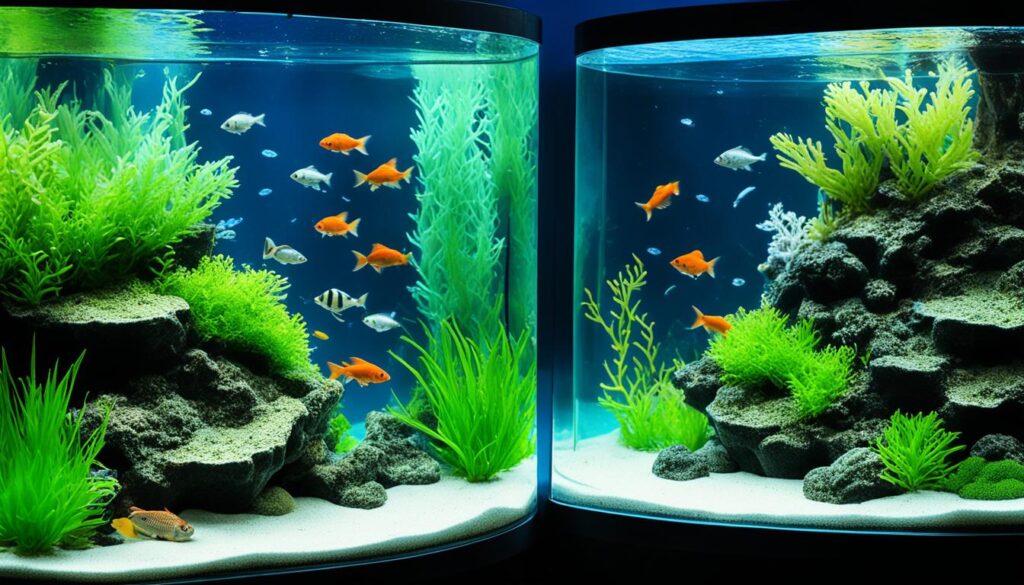
Important Considerations for Cycling an Aquarium
When cycling an aquarium, there are several important considerations to keep in mind to ensure a successful and healthy process.
| Consideration | Description |
|---|---|
| Choose the right fish | Opt for hardy fish that are less sensitive to ammonia and nitrite levels. This will minimize stress and allow for a smoother cycling process. |
| Monitor water parameters | Regularly test and monitor ammonia, nitrite, and nitrate levels using appropriate testing kits. This will help you gauge the progress of the cycling process and ensure that the tank is safe for fish. |
| Adjust feeding habits | During cycling, feed fish sparingly to avoid excessive waste production. Overfeeding can lead to elevated levels of ammonia and nitrite, which can be harmful to the fish and slow down the cycling process. |
| Consider using beneficial bacteria supplements | Adding beneficial bacteria supplements can help speed up the cycling process by introducing nitrifying bacteria to the tank. These supplements contain live bacteria that can help establish a healthy biological filter more quickly. |
| Do not overcrowd the tank | Adding too many fish during the cycling process can overload the biological filter and disrupt the establishment of beneficial bacteria. Start with a small number of fish and gradually increase the population once the tank is fully cycled. |
| Monitor fish behavior | Watch for any signs of stress or illness in the fish, such as lack of appetite, rapid breathing, or abnormal swimming patterns. If these symptoms arise, take immediate action to address the issue and protect the health of the fish. |
By keeping these considerations in mind and providing the necessary care and attention to your aquarium during the cycling process, you can lay the foundation for a thriving aquatic environment.
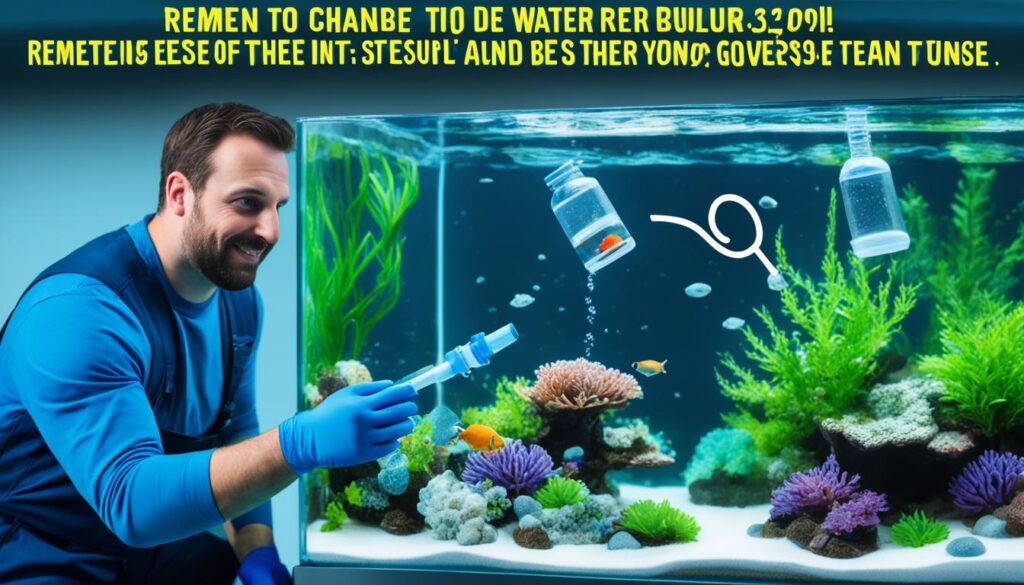
The Role of Water Changes in Fish Tank Health
Water changes are an essential aspect of maintaining the overall health and well-being of your fish tank. They play a crucial role in removing contaminants, maintaining water parameters, and preventing the buildup of toxins. Regular small water changes contribute to a healthy and stable environment for your fish, promoting their overall well-being and reducing the risk of diseases.
By performing regular water changes, you can effectively remove accumulated pollutants such as uneaten food, fish waste, and decaying organic matter. This helps to maintain optimal water quality and prevent the accumulation of harmful substances that can adversely affect the health of your fish.
“Regular water changes ensure a clean and safe environment for your fish, reducing stress and promoting their overall vitality.” – [Your Name]
In addition to removing contaminants, water changes also assist in maintaining essential water parameters such as pH, temperature, and mineral levels. Fluctuations in these parameters can be harmful to fish, causing stress and potentially leading to health issues. By regularly replacing a portion of the water, you can help maintain stability in these parameters, creating a more consistent and comfortable environment for your fish.
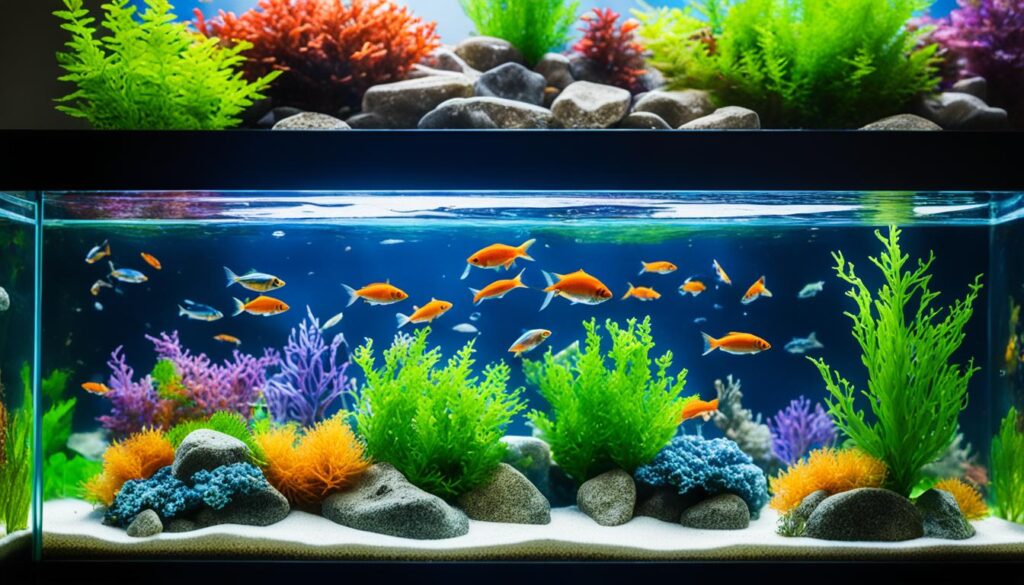
Moreover, water changes help prevent the buildup of toxins such as ammonia and nitrite. These substances are byproducts of fish waste and decomposing matter. Elevated levels of ammonia and nitrite can be extremely harmful to fish, causing stress, breathing difficulties, and even death. By performing regular water changes, you ensure that these toxins are diluted and kept at safe levels, reducing the risk of toxic stress on your fish.
Establishing a regular water change schedule is essential for maintaining fish tank health. The frequency and volume of your water changes depend on factors such as the size of your tank, the number and species of fish, and the filtration system in place. It is recommended to perform small, frequent water changes rather than infrequent large changes, as this helps maintain more stable water conditions and reduces the stress on your fish.
Benefits of Regular Water Changes:
- Promote fish health and well-being
- Remove contaminants and pollutions
- Maintain stable water parameters
- Prevent the buildup of toxins
- Reduce the risk of diseases
By recognizing the importance of water changes in fish tank health, you can take proactive measures to create a thriving and vibrant aquatic habitat for your fish. Implementing regular water changes as part of your aquarium maintenance routine will contribute to the longevity and vitality of your fish, ensuring a beautiful and enjoyable underwater world.
Tips for Successful Aquarium Cycling
Ensuring successful aquarium cycling is essential for creating a healthy environment for your aquatic friends. Here are some tips to help you achieve a successful cycling process:
- Test your water regularly: Monitoring ammonia, nitrite, and nitrate levels is crucial during the cycling process. Regular testing allows you to track the progress and ensure that the harmful toxins are reducing over time.
- Start with hardy fish: If you choose to cycle your aquarium with fish, select hardy species that are more tolerant of fluctuating water conditions. This minimizes stress on the fish while providing the ammonia needed for bacterial growth.
- Consider fishless cycling: Fishless cycling is a humane alternative that avoids subjecting fish to potentially harmful conditions. You can introduce ammonia from alternative sources, such as fish food, to simulate the waste produced by fish.
- Perform regular water changes: Contrary to common misconceptions, small water changes during the cycling process are beneficial. They help dilute toxins and maintain water quality, contributing to a healthier environment for both fish and beneficial bacteria.
- Avoid overfeeding: Excessive feeding leads to increased ammonia levels in the water, which can impede the cycling process. Feed your fish sparingly during cycling to minimize ammonia accumulation.
- Be patient: Aquarium cycling takes time, and it is important to allow the beneficial bacteria to establish naturally. Avoid rushing the process or introducing too many fish before the biological filter is fully established.
By implementing these tips, you can ensure a successful aquarium cycling process and provide a thriving habitat for your aquatic pets.
Conclusion
Proper water changes are crucial during the aquarium cycling process to ensure a healthy habitat for your fish. Despite common misconceptions, water changes do not disrupt the cycling process. In fact, they play a vital role in speeding it up and maintaining fish health. Whether you choose to cycle with or without fish, regular monitoring of water parameters and creating a stable environment are key considerations.
By following the proper steps and considerations outlined in this article, you can successfully cycle your aquarium and provide a thriving home for your aquatic friends. Remember, the aquarium cycling process is essential for creating a biologically safe environment for fish. It establishes nitrifying bacteria that regulate the nitrogen cycle, converting harmful ammonia and nitrite into less toxic nitrate.
Take the time to carefully monitor water parameters, such as pH and temperature, and perform small, frequent water changes to keep ammonia and nitrite levels in check. This will help the beneficial bacteria establish and thrive, ultimately leading to a healthy and stable aquarium for your fish to thrive in. With patience and proper care, you can create a beautiful underwater ecosystem that brings joy and relaxation to your home.
FAQ
How often should I perform water changes during the aquarium cycling process?
Performing small, frequent water changes is recommended during the aquarium cycling process. It helps keep ammonia and nitrite levels low, which are toxic to fish. Neglecting water changes during cycling is inhumane and irresponsible.
Do water changes delay or hinder the cycling process?
No, water changes do not delay or hinder the cycling process in a tank. In fact, small, frequent water changes can actually speed up the process by reducing ammonia and nitrite levels, promoting the growth of beneficial bacteria.
Will water changes remove the beneficial bacteria from the tank?
No, water changes do not remove significant amounts of beneficial bacteria from the tank. The bacteria are typically attached to surfaces in the biological filter and remain unaffected by small water changes.
How do water changes help speed up the cycling process?
Water changes help speed up the cycling process by reducing elevated levels of ammonia and nitrite in the tank. By removing some of the waste through water changes, the nitrifying bacteria can process the remaining waste more efficiently and establish a biological filter faster.
Why is aquarium cycling important?
Aquarium cycling is vital for creating a biologically safe environment for fish. It establishes nitrifying bacteria that convert harmful ammonia and nitrite into less toxic nitrate. Without cycling, the buildup of ammonia and nitrite can be harmful to fish.
How long does aquarium cycling typically take to complete?
Aquarium cycling usually takes about four to eight weeks to complete. The duration may vary depending on factors such as tank size, water pH, and temperature.
What are the steps to properly cycle an aquarium?
The steps to properly cycle an aquarium include setting up the tank, adding a source of ammonia, testing and maintaining water parameters, monitoring the cycling progress, and performing regular water changes. A detailed step-by-step guide can be found in the full article.
What is the difference between cycling with fish and fishless cycling?
Cycling with fish involves introducing a few hardy fish to provide the necessary ammonia for the cycling process. Fishless cycling, on the other hand, uses alternative sources of ammonia without the need to add live fish to the tank. Fishless cycling is generally recommended for beginners as it is more humane and less prone to fish stress.
What considerations should I keep in mind when cycling an aquarium?
Some important considerations when cycling an aquarium include choosing the appropriate cycling method (with fish or fishless), monitoring water parameters regularly, maintaining a stable environment, and providing proper care for the fish during the cycling process.
How do water changes contribute to fish tank health?
Water changes play a crucial role in maintaining overall fish tank health. They help remove contaminants, replenish oxygen levels, maintain water parameters, and prevent the buildup of toxins. Regular small water changes promote fish health and reduce the risk of diseases.
What are some tips for successful aquarium cycling?
Some tips for successful aquarium cycling include using a reliable water test kit, establishing a regular water change schedule, monitoring water parameters closely, maintaining a stable environment, and being patient throughout the cycling process. Additional tips can be found in the full article.

